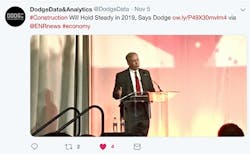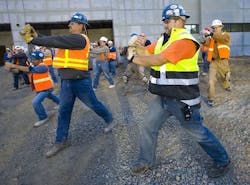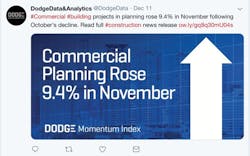There is no denying it. Even as political crises deepen both here and abroad, economic clouds are gathering now in 2019. Yet the general consensus among seasoned industry observers is still that this year should remain relatively strong for new business, with even the most pessimistic prognosticators predicting flat growth, or slight declines, at worst.
“For 2019, it’s expected that growth for the U.S. economy won’t be quite as strong as what’s taking place in 2018, as the benefits of tax cuts begin to wane,” said Robert A. Murray, chief economist for Dodge Data & Analytics, which released its 80th annual Dodge Construction Outlook report last fall. “For 2019, total construction starts are forecast to hold basically steady at $808 billion... [despite] mounting headwinds affecting construction, namely rising interest rates and higher material costs,” he added.
In the commercial market, Dodge Data predicts that U.S. construction starts will retreat 3% in 2019, following 2% gains in 2017 and 2018. The new forecast explained:
While 2018 market fundamentals for offices and warehouses are healthy, next year vacancy rates are expected to rise as the economy slows, slightly dampening construction. Hotel construction will ease back from recent strength, and store construction will experience further weakness.
Institutional building will advance 3%, picking up the pace slightly from its 1% gain in 2018, which itself followed an 18% hike in 2017. Educational facilities should see continued growth in 2019, supported by funding coming from numerous school construction bond measures. Healthcare projects will make a partial rebound after pulling back in 2018. Airport terminal and amusement-related projects are expected to stay close to the elevated levels of construction starts reported in 2017 and 2018.
Ten years after the global market’s collapse in the fall of 2008, such deceleration in the U.S. economy’s rebounding rate of growth was to be expected, especially now as the ongoing “expansion matures,” noted Murray. “After advancing 11% to 14% each year from 2012 through 2015, total construction starts climbed 7% in both 2016 and 2017, with a 3% increase estimated for 2018,” he added.
Some industry forecasters remain more bullish for 2019, with the Portland Cement Association predicting a 2.4% gain for construction put-in-place, led by an anticipated 5% rise in industrial projects and a 2.7% boost for commercial offices. For its part, FMI Corp. is forecasting a 5.6% rise in total construction put-in-place this year, including a 5.9% bump for education projects and a 4.4% climb for healthcare work.
With all that in mind, HPAC Engineering took the pulse of some of our “usual suspects” for this issue to see how they view What’s New and What’s Next for 2019. What follows is a selection of their insights heading into the new year. For more, please visit www.hpac.com.
ENERGY AND ENVIRONMENT
“Energy and environmental policy has not been high on the current Administration’s agenda—evidenced by (the U.S.) not joining nearly five dozen other countries in ratifying the Kigali Amendment of the Montreal Protocol, withdrawing from the Paris climate change agreement, and rolling back EPA SNAP rules around HFC emissions,” notes John Galyen, president of equipment manufacturer Danfoss North America. “With a divided Congress set to take office in 2019, it is difficult to predict what, if any, regulatory movement could be in store. However, in the absence of Federal leadership, many states have begun to take action on their own. California, Connecticut, Maryland, and New York already have announced plans to address refrigerant emissions, and the U.S. Climate Alliance, a bipartisan federation of 17 states, is working to reduce GHG emissions consistent with the goals of the Paris agreement.”
At the same time, he adds, urban centers around the world—like the C40 cities—also are acting to influence their local objectives around energy and environmental sustainability. “This is creating a growing risk of patchwork regulations that could significantly impact the commercial building and HVACR industry—not just in the U.S., but around the world,” says Galyen.
Echoing that ‘ground-up’ leadership on environmental issues, our own Larry Clark, owner of Sustainable Performance Solutions LLC in South Florida, predicts that we should expect to see more clean energy financing this year. “In 2017, I reported that nationally there were more than $340 million in property-assessed clean energy (PACE) loans,” says Clark. Although the final numbers for 2018 have not yet been recorded, he adds, “CleanFund Commercial PACE Capital announced the closing of a securitization backed by $115million of c-PACE assessments on 82 properties in six states, representing the largest c-PACE securitization to date. So, look for that trend to continue in 2019 as well.”
Adds Keith Glasch, president of air control equipment maker, Ruskin, a subsidiary of Johnson Controls: “More states and municipalities are also adopting Air Movement and Control Association (AMCA) 540 and 550 codes to protect buildings against extreme weather events. (We) are leading the charge to create louver systems that help keep debris and rain out of buildings. We recently expanded our Grandview, MO, laboratory to help us engineer new products that support extreme weather protection.”
TECHNOLOGY AND SECURITY
“One intriguing trend that we are seeing is that contractors are starting to devote more resources to research and testing,” says Sean McGuire, director of construction technology at the Mechanical Contractors Association of America, Rockville MD. “This extends to the personnel level, as well, where a new job title is emerging: the Construction Technologist, or ‘ConTech’, for short.”
These are individuals who are devoting their time to research, product evaluation, testing and eventually integration, he explains.
“They do not work on BIM or IT primarily because it is imposible to carve out the extra time that R&D requires,” adds McGuire. “The benefit right now is that as manufacturers are developing all this new technology, they are eagerly looking for ConTechs to beta test and collaborate with.
They need both real world product testing and intelligent feedback. ConTechs can help provide that while simultaneously getting access to better tools and processes.”
This “symbiotic relationship” is helping to push innovation in the industry, he adds, so firms that already have ‘ConTechs’ are reaping some of the early rewards.
Danfoss President Galyen also sees technology as a continuing game-changer.
“More connected products and services means more sensors, and a new, more holistic approach to building design and a greater level of system integration,” he says. “It’s been estimated that, by 2020, one million new devices will come online every hour—underscoring a dramatic and significant opportunity for the industry, especially given the increasing demand for data, remote communication, monitoring, and service.”
This global megatrend toward digitalization also will facilitate strong, reliable predictive maintenance of building systems, helping to reduce downtime and improve performance—and enable contractors to be more productive, Galyen adds.
Of course, the downside of all this connectivity is the exponential exposure that the internet of things (IoT) brings to our critical business communication and operating systems.
IoT technologies are being applied across more and more buildings and touching more and more systems within them, especially HVAC, lighting and power,” notes Ian Dempster, senior director of product innovation at Optimum Energy. “People are just waking up to the real security risks of these systems.”
Adds security expert Nick Espinosa, “In the construction industry mobile workforces are easy targets due to the use free internet connections at places like coffee shops, hotels and other places as well as a lack of a full mobile device management system, which I rarely see running when dealing with the construction and mechanical verticals. In 2019, proper cyber-defense for the mobile workforce should be on everyone’s mind,” he warns.
Dempster echoes that concern. “Now is the time to harden our IoT systems by shoring up the data and security holes,” he says. “Security and privacy for IoT needs to be a focus, not the afterthought it has been… No one should have access to data they don’t need.”
About the Author
Rob McManamy
Editor in Chief
An industry reporter and editor since 1987, McManamy joined HPAC Engineering in September 2017, after three years with BuiltWorlds.com, a Chicago-based media startup focused on tech innovation in the built environment. He has been covering design and construction issues for more than 30 years, having started at Engineering News-Record (ENR) in New York, before becoming its Midwest Bureau Chief in 1990. In 1998, McManamy was named Editor-in-Chief of Design-Build magazine, where he served for four years. He subsequently worked as an editor and freelance writer for Building Design + Construction and Public Works magazines.
A native of Bronx, NY, he is a graduate of both the University of Virginia, and The John Marshall Law School in Chicago.
Contact him at [email protected].





